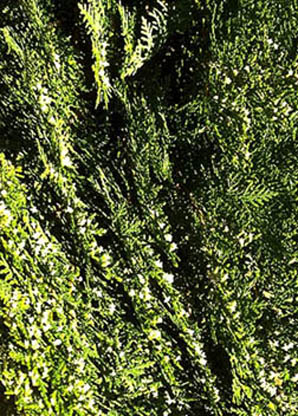Platycladus occidentalis
(Thuja occidentalis)
 Common: American arborvitae, White cedar, Eastern arborvitae, Northern white cedar
Common: American arborvitae, White cedar, Eastern arborvitae, Northern white cedar
Family: Cupressaceae
Origin: Native to eastern United States. Distribution from Nova Scotia to Maine and westward to Minnesota and Manitoba; southward in Illinois, Indiana, Ohio and New York, and located in Appalachian Mountains.
Light: Full sun or light shade
Water: Tolerates wet soils
Temperature: Estimated to have tolerance of annual temperature of 5 to 13 degrees C.
Long established in American gardens. Used as foundation, hedge, screen or accent plants. Use on both sides of entrances. Makes nice contrast with other gray foliage plants. Covers bareness of deciduous trees during dormancy.
Tall, slender shrub. At maturity, usually dense, pyramidal, 40 to 50 feet. Cultivars range from dwarf to rounded to globe shapes. Branches are erect and spreading, with thin, scaly bark. Branches tend to turn up at ends. Needlelike juvenile leaves and scale-like mature foliage and branchlets, flattened in one plane. Bright green to yellow-green.
Ojibwa Indians are said to have made soup from the inner bark of the young twigs of this tree. The twigs are used to make teas, perhaps more medicinal than culinary. The essential oil from this plant is used in cleansers, disinfectants, hair preparations, insecticides, liniment, room sprays and soft soaps. Three of these trees are located north of Old Main in the big tree area. Arborvitae is latin for "tree of life."